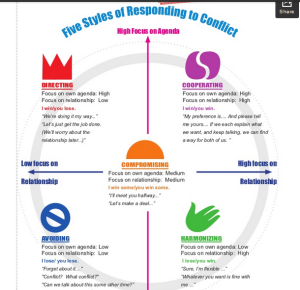“Peace is not the absence of conflict but the presence of creative alternatives for responding to conflict — alternatives to passive or aggressive responses, alternatives to violence.”
– Dorothy Thompson
Yesterday I attended a conflict management workshop that I’d signed up for since I didn’t want to squander the opportunity to make use of the professional development resources that my workplace offers. You know, I’ve booked our venue for that particular facilitator before and our management staff would always make snarky commentary about the fact that the facilitator would book the room to set up for the event on the night before. I eventually was able to steer to conversation back on topic by looking wide-eyed and really uncomfortable and then delicately following up with the comment, “I’m sure he means well…” and then those that encouraged the behavior would start to feel a little bit uncomfortable, the laughter would die down and that would sort of be the end of it.
After attending today’s training session, however, I can see where the extra planning went. The facilitator did not just read off a bunch of slides to us or or even force us to talk about uncomfortable issues, he really took us through an artfully facilitated experience. It was so well-executed in fact that I knew about 5 minutes into it that when I got home I was going to more than likely blog about it.

Healthy approaches to Conflict, and knowing when to use them, can provide a variety of benefits. Mindmap
One of the major emphases of this session that he wanted us to focus upon was upon understanding how our own personal conflict styles impacted our perception of the way others approached conflict. So he took us through a Kraybill Conflict Style Inventory and then had us read over and discuss whether we noticed correlations within our behavior when we experienced what he referred to as “storm shifts” in behavior as we watched conflicts escalate.
I scored almost identically under the cooperative conflict style for my primary (calm) and secondary (storming) mechanisms for approaching conflict. Some of the costs associated with over-using this particular style included
- fatigue & time loss
- distraction from more important tasks
- analysis paralysis
- exhaustion from fear of “too much processing”
particularly if the person using this framework is unskilled in dealing with conflict. The benefits, however, include a high potential for increased creativity and personal growth, a better understanding of the situation, the opportunity to build team cohesion and self knowledge.
My particular pattern typically played out the following way: my first reaction to conflict is to tend and directly address the issue at hand to negotiate for the win-win, but if these attempts are rejected I respond to the shock I experience by withdrawing momentarily to gather relevant data and information, so that I can assess it in a calm and methodical way in order to comfortably enter negotiations and resolve them efficiently once things have calmed down.
I might look for relevant details, plans, options, weigh costs, check for policy compliance, and precedents from elsewhere before making that decision, and if the situation requires a directive, I either make it and do the best I can to explain what course of action I’ve taken, who’s involved in that process if they want to appeal and my basis for evidence that led me to the decision. Occasionally those discussions may take place retroactively, but once I have better information it becomes easy to let the person I’m experiencing conflict with make a decision about how they are going to react to this conflict, what they stand to benefit and what’s at risk should they choose an action that doesn’t reflect everyone’s best interest.
What I also learned is that your previous experiences with a particular conflict style (e.g. I associate those who raise their voice or snap at others in order to be dismissive with prior associations in which those who used that style, often people who I cared about very deeply, resurfaced that conflict because of some previous form of conflict they hadn’t resolved previously that left them feeling un-affirmed, hurt and afraid of being abandoned when they encountered that previous conflict… and those patterns of behavior, that imprinting was passed on. Often large, demonstrative expressions of anger reflect
- accumulation of resentment due to needs that haven’t been acknowledged or met
- a fear of being perceived as weak or threatened when approached to engage with someone they haven’t built trust with but have been approached by to engage in conflict
- resistance out of the belief that one is being denied the right to be validated for simply being themselves
- inability to articulate of boundaries
According to the book that was recommended to us to supplement the assessment: Style Matters, when dealing with those who have a more in-your-face conflict style or a history of abusing others, my best plan of action is to withdraw to safety but I need to express when I do so a clear intention to return and work on things once things cool off. Otherwise it will escalate their anxiety and increase the likelihood of the behavior increasing.
Susan Wheelan states that:
“We know from our experience that it is easier to develop trust in another person or in a group if we believe that we can disagree, and we will not be abandoned or hurt for our differences. It is difficult to trust those who deny us the right to be ourselves.”
Kraybill seemed to believe that a direct correlation existed between the way a person approached a particular conflict style and the importance we placed upon whether we valued our agendas more over our relationships. I realize now that the emphasis I place upon how important the agenda I’d like to convey definitely determines the approach I display when working through conflict because I absolutely hate the idea of giving up on a relationship, especially if I find the relationship to be important. But the moment that I realize that the other party places little value upon the relationship, the easier it is for me to divest and redirect my emphasis upon confirming my rationalization (coming up with evidence for whether/why I’m right in case I have to protect myself) rather than placating the other person in order to try and salvage that relationship.
So I suppose in a way, I can be a bit willful myself. But I think having that self knowledge and understanding which considerations I need to make (e.g.
- whether the circumstance requires that I place more importance upon the relationship or the issue,
- the time and energy constraints for addressing the conflict,
- weighing potential consequences,
- and alternative approaches to mitigate any damaging effects).
We may be able to move forward and to develop more healthy and appropriate avenues for working through workplace conflict.


